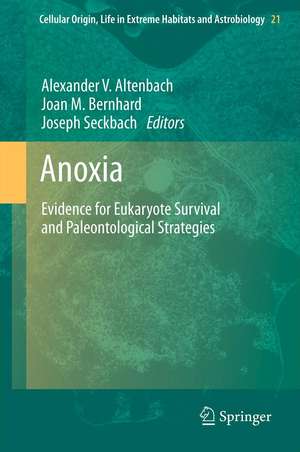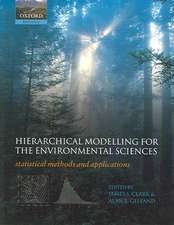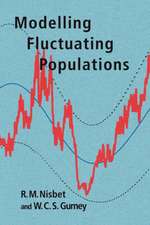Anoxia: Evidence for Eukaryote Survival and Paleontological Strategies: Cellular Origin, Life in Extreme Habitats and Astrobiology, cartea 21
Editat de Alexander Altenbach, Joan M. Bernhard, Joseph Seckbachen Limba Engleză Paperback – 30 noi 2013
| Toate formatele și edițiile | Preț | Express |
|---|---|---|
| Paperback (1) | 1235.08 lei 6-8 săpt. | |
| SPRINGER NETHERLANDS – 30 noi 2013 | 1235.08 lei 6-8 săpt. | |
| Hardback (1) | 1240.16 lei 6-8 săpt. | |
| SPRINGER NETHERLANDS – 20 oct 2011 | 1240.16 lei 6-8 săpt. |
Din seria Cellular Origin, Life in Extreme Habitats and Astrobiology
- 18%
 Preț: 1683.66 lei
Preț: 1683.66 lei - 5%
 Preț: 1440.04 lei
Preț: 1440.04 lei - 18%
 Preț: 1839.32 lei
Preț: 1839.32 lei - 18%
 Preț: 1848.33 lei
Preț: 1848.33 lei - 18%
 Preț: 1839.32 lei
Preț: 1839.32 lei - 18%
 Preț: 1222.27 lei
Preț: 1222.27 lei - 18%
 Preț: 1232.26 lei
Preț: 1232.26 lei - 18%
 Preț: 2098.03 lei
Preț: 2098.03 lei - 18%
 Preț: 1228.29 lei
Preț: 1228.29 lei - 18%
 Preț: 2111.46 lei
Preț: 2111.46 lei - 24%
 Preț: 1076.36 lei
Preț: 1076.36 lei - 18%
 Preț: 1828.11 lei
Preț: 1828.11 lei - 18%
 Preț: 951.14 lei
Preț: 951.14 lei - 18%
 Preț: 1219.94 lei
Preț: 1219.94 lei - 18%
 Preț: 1252.76 lei
Preț: 1252.76 lei - 18%
 Preț: 1263.01 lei
Preț: 1263.01 lei - 18%
 Preț: 956.50 lei
Preț: 956.50 lei - 18%
 Preț: 956.03 lei
Preț: 956.03 lei - 18%
 Preț: 1234.46 lei
Preț: 1234.46 lei - 18%
 Preț: 1122.58 lei
Preț: 1122.58 lei - 15%
 Preț: 646.11 lei
Preț: 646.11 lei - 18%
 Preț: 1840.91 lei
Preț: 1840.91 lei - 18%
 Preț: 1231.16 lei
Preț: 1231.16 lei - 18%
 Preț: 1251.50 lei
Preț: 1251.50 lei - 18%
 Preț: 961.41 lei
Preț: 961.41 lei
Preț: 1235.08 lei
Preț vechi: 1506.20 lei
-18% Nou
Puncte Express: 1853
Preț estimativ în valută:
236.33€ • 246.75$ • 195.59£
236.33€ • 246.75$ • 195.59£
Carte tipărită la comandă
Livrare economică 04-18 aprilie
Preluare comenzi: 021 569.72.76
Specificații
ISBN-13: 9789400737051
ISBN-10: 940073705X
Pagini: 684
Ilustrații: XXXVI, 648 p.
Dimensiuni: 155 x 235 x 36 mm
Greutate: 0.94 kg
Ediția:2012
Editura: SPRINGER NETHERLANDS
Colecția Springer
Seria Cellular Origin, Life in Extreme Habitats and Astrobiology
Locul publicării:Dordrecht, Netherlands
ISBN-10: 940073705X
Pagini: 684
Ilustrații: XXXVI, 648 p.
Dimensiuni: 155 x 235 x 36 mm
Greutate: 0.94 kg
Ediția:2012
Editura: SPRINGER NETHERLANDS
Colecția Springer
Seria Cellular Origin, Life in Extreme Habitats and Astrobiology
Locul publicării:Dordrecht, Netherlands
Public țintă
Upper undergraduateCuprins
Introduction.- Stepping into the book of Eukaryotes and Anoxia.- List of Authors and their Addresses.- List of External Reviewers and Referees.- Acknowledgment to authors, reviewers and any special people who assisted.-
PART I: GENERAL INTRODUCTION.- Anaerobic eukaryotes.- Biogeochemical reactions in marine sediments underlying anoxic water bodies.- Diversity of anaerobic prokaryotes and eukaryotes – breaking long-established dogmas.- PART II: FUNCTIONAL BIOCHEMISTRY.- The biochemical adaptations of mitochondrion-related organelles of parasitic and free-living microbial eukaryotes to low oxygen environments.- Hydrogenosomes and mitosomes: mitochondrial adaptations to life in anaerobic environments.- Adapting to hypoxia: lessons from vascular endothelial growth factor.- PART III: MANAGING ANOXIA.- Magnetotactic protists at the oxic-anoxic transition zones of coastal aquatic environments.- A novel ciliate (Ciliophora: Hypotrichida) isolated from bathyal anoxic sediments.- The wood-eating termite hindgut: diverse cellular symbioses in a microoxic to anoxic environment.- Ecological and experimental exposure of insects to anoxia reveals suprising tolerance.- The unusual response of encysted embryos of the animal extremophile, Artemia franciscana, to prolonged anoxia.- Survival of tardigrades in extreme environments – a model animal for astrobiology.- Long-term anoxia-tolerance in flowering plants.- PART IV: FORAMINIFERA.- Benthic Foraminifera: inhabitants of low-oxygen environments.- Ecological and biological response of benthic Foraminifera under oxygen-depleted conditions: evidence from laboratory approaches.- The response of benthic Foraminifera to low-oxygen conditions of the Peruvian oxygen minimum zone.- Benthic foraminiferal communities and microhabitat selection on the continental shelf off central Peru.- PART V: ZONES AND REGIONS.- Living assemblages from the “Dead Zone” and naturally occurring hypoxic zones.- Thereturn of shallow shelf seas as extreme environments: Anoxia and macrofauna reactions in the northern Adriatic Sea.- Meiobenthos of the oxic/anoxic interface in the south-western region of the Black Sea: abundance and taxonomic composition.- The role of eukaryotes in the anaerobic food web of stratified lakes.- The anoxic Framvaren fjord as a model system to study protistan diversity and evolution.- Characterizing an anoxic habitat: sulphur bacteria in a meromictic alpine lake.- Ophel, the newly discovered hypoxic chemolitho-autotrophic groundwater biome - a window to ancient animal life.- Microbial eukaryotes in the marine subsurface? - PART VI: MODERN ANALOGS AND TEMPLATES FOR EARTH HISTORY.- On the use of stable nitrogen isotopes in present and past anoxic environments.- Carbon and nitrogen isotopic fractionation in Foraminifera: possible signatures from anoxia.- The functionality of pores in benthic Foraminifera in view of bottom water oxygenation. A review.- Anoxia-dysoxia at the sediment-water interface of the southern Tethys in the late Cretaceous: Mishash formation, southern Israel.- Styles of agglutination in benthic Foraminifera from modern Santa Barbara basin sediments and the implications of finding fossil analogs in Devonian and Mississippian black shales.- Did redox conditions trigger test templates in Proterozoic Foraminifera?- The relevance of anoxic and agglutinated benthic Foraminifera to the possible Archean evolution of eukaryotes.- PART VII: FINALS.
PART I: GENERAL INTRODUCTION.- Anaerobic eukaryotes.- Biogeochemical reactions in marine sediments underlying anoxic water bodies.- Diversity of anaerobic prokaryotes and eukaryotes – breaking long-established dogmas.- PART II: FUNCTIONAL BIOCHEMISTRY.- The biochemical adaptations of mitochondrion-related organelles of parasitic and free-living microbial eukaryotes to low oxygen environments.- Hydrogenosomes and mitosomes: mitochondrial adaptations to life in anaerobic environments.- Adapting to hypoxia: lessons from vascular endothelial growth factor.- PART III: MANAGING ANOXIA.- Magnetotactic protists at the oxic-anoxic transition zones of coastal aquatic environments.- A novel ciliate (Ciliophora: Hypotrichida) isolated from bathyal anoxic sediments.- The wood-eating termite hindgut: diverse cellular symbioses in a microoxic to anoxic environment.- Ecological and experimental exposure of insects to anoxia reveals suprising tolerance.- The unusual response of encysted embryos of the animal extremophile, Artemia franciscana, to prolonged anoxia.- Survival of tardigrades in extreme environments – a model animal for astrobiology.- Long-term anoxia-tolerance in flowering plants.- PART IV: FORAMINIFERA.- Benthic Foraminifera: inhabitants of low-oxygen environments.- Ecological and biological response of benthic Foraminifera under oxygen-depleted conditions: evidence from laboratory approaches.- The response of benthic Foraminifera to low-oxygen conditions of the Peruvian oxygen minimum zone.- Benthic foraminiferal communities and microhabitat selection on the continental shelf off central Peru.- PART V: ZONES AND REGIONS.- Living assemblages from the “Dead Zone” and naturally occurring hypoxic zones.- Thereturn of shallow shelf seas as extreme environments: Anoxia and macrofauna reactions in the northern Adriatic Sea.- Meiobenthos of the oxic/anoxic interface in the south-western region of the Black Sea: abundance and taxonomic composition.- The role of eukaryotes in the anaerobic food web of stratified lakes.- The anoxic Framvaren fjord as a model system to study protistan diversity and evolution.- Characterizing an anoxic habitat: sulphur bacteria in a meromictic alpine lake.- Ophel, the newly discovered hypoxic chemolitho-autotrophic groundwater biome - a window to ancient animal life.- Microbial eukaryotes in the marine subsurface? - PART VI: MODERN ANALOGS AND TEMPLATES FOR EARTH HISTORY.- On the use of stable nitrogen isotopes in present and past anoxic environments.- Carbon and nitrogen isotopic fractionation in Foraminifera: possible signatures from anoxia.- The functionality of pores in benthic Foraminifera in view of bottom water oxygenation. A review.- Anoxia-dysoxia at the sediment-water interface of the southern Tethys in the late Cretaceous: Mishash formation, southern Israel.- Styles of agglutination in benthic Foraminifera from modern Santa Barbara basin sediments and the implications of finding fossil analogs in Devonian and Mississippian black shales.- Did redox conditions trigger test templates in Proterozoic Foraminifera?- The relevance of anoxic and agglutinated benthic Foraminifera to the possible Archean evolution of eukaryotes.- PART VII: FINALS.
Textul de pe ultima copertă
ANOXIA defines the lack of free molecular oxygen in an environment. In the presence of organic matter, the metabolism of anaerobic prokaryotes soon produces compounds such as free radicals, hydrogen sulfide, or methane that are typically toxic to aerobes. The concomitance of suppressed respiration and the presence of toxic substances suggests that these habitats are inhospitable to eukaryotes. Ecological definitions thus sometimes term these environments 'Death Zones'. In this book, however, we present a collection of remarkable adaptations to anoxia, observed in protists, fungi, plants and animals. Presented are case studies that provide evidence for controlled beneficial use of anoxia by, for example, organic modification of free radicals, use of alternative electron donors for anaerobic metabolic pathways, and employment of anaerobic symbionts. Marine, freshwater, and terrestrial organisms and habitats are considered. Ecological, cell biological, and physiological studies are included. In addition to these biologically oriented chapters, the book also presents a paleontological perspective by discussing indirect and direct evidence of eukaryote survival in ancient times. For example, the complex and often interwoven existence of oxic and anoxic milieus in space and time is also highlighted. Finally, we revisit the idea that eukaryotic inhabitation of anoxic habitats was established early in Earth history. This book will certainly increase your concepts regarding abilities of EUKARYOTA.
Caracteristici
Reveals eukaryotic strategies in anoxic environments Includes cutting-edge research, data and hypotheses never before published Offers also fundamental introductions, overviews and an exhaustive collection of literature for advanced studies
















